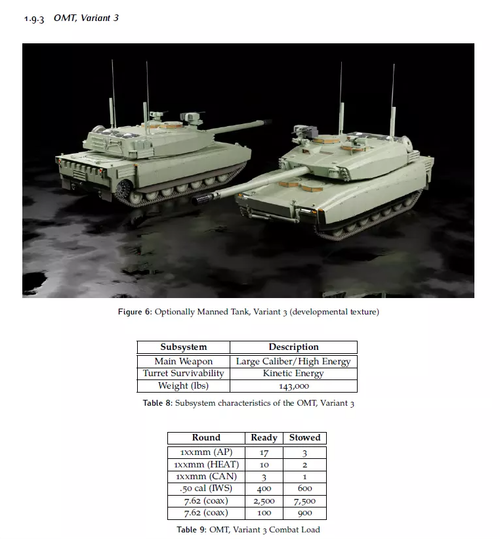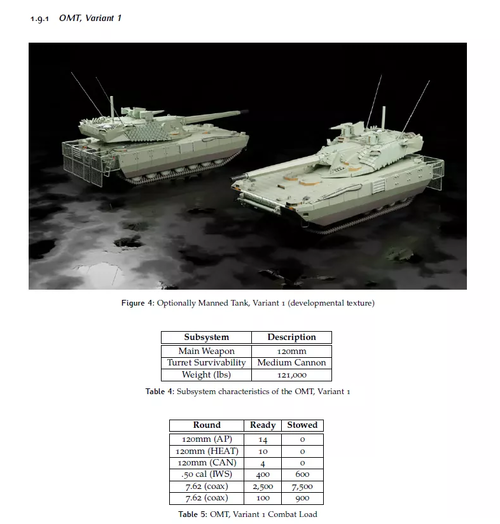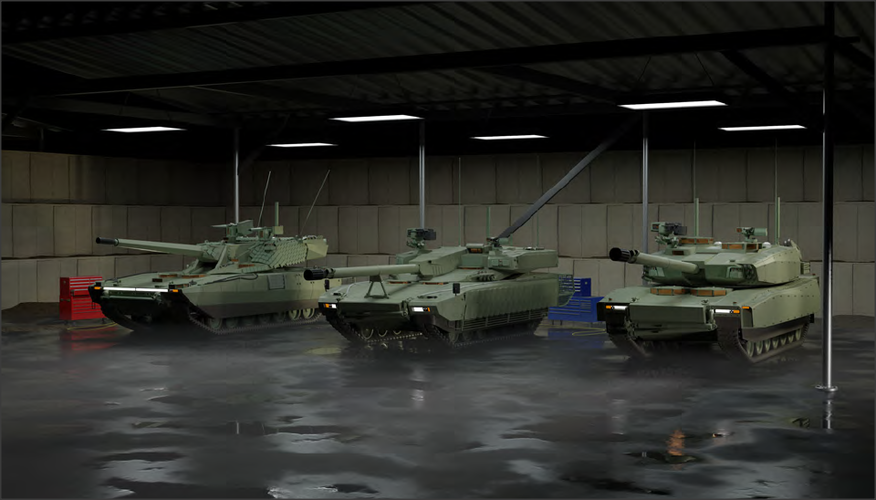You are using an out of date browser. It may not display this or other websites correctly.
You should upgrade or use an alternative browser.
You should upgrade or use an alternative browser.
M1 Abrams MBT Replacement
Bruno Anthony
I miss the Cold War
- Joined
- 5 August 2012
- Messages
- 635
- Reaction score
- 639
In 2021 seems will be testing M1A2 SEP V4 Super Abrams or denominated like version M1A2D . Last version for now are M1A2C ( in service) and M1A2D ready for testing on 2021.
Not to sound too pessimistic, but what’s going to be super?
Probably some technlogy improvement .In 2021 seems will be testing M1A2 SEP V4 Super Abrams or denominated like version M1A2D . Last version for now are M1A2C ( in service) and M1A2D ready for testing on 2021.
Not to sound too pessimistic, but what’s going to be super?
- Joined
- 16 April 2008
- Messages
- 9,605
- Reaction score
- 14,494
Probably some technlogy improvement .In 2021 seems will be testing M1A2 SEP V4 Super Abrams or denominated like version M1A2D . Last version for now are M1A2C ( in service) and M1A2D ready for testing on 2021.
Not to sound too pessimistic, but what’s going to be super?
Mostly electronics, starting with a new dual-band high-res FLIR, an integrated vehicle network, some ammo and fire control upgrades, all-around color cameras, laser warning, etc.
Trophy Active Protection System installation is happening in parallel with SEP v4, but isn't aligned with it, AFAIK, so there will probably be both SEP V3 and V4 tanks with Trophy as it rolls out.
Bruno Anthony
I miss the Cold War
- Joined
- 5 August 2012
- Messages
- 635
- Reaction score
- 639
Probably some technlogy improvement .In 2021 seems will be testing M1A2 SEP V4 Super Abrams or denominated like version M1A2D . Last version for now are M1A2C ( in service) and M1A2D ready for testing on 2021.
Not to sound too pessimistic, but what’s going to be super?
Mostly electronics, starting with a new dual-band high-res FLIR, an integrated vehicle network, some ammo and fire control upgrades, all-around color cameras, laser warning, etc.
Trophy Active Protection System installation is happening in parallel with SEP v4, but isn't aligned with it, AFAIK, so there will probably be both SEP V3 and V4 tanks with Trophy as it rolls out.
Thank you for the details. More tinkering at the margins?
Sounds like the Abrams forever
- Joined
- 21 April 2009
- Messages
- 13,756
- Reaction score
- 7,695
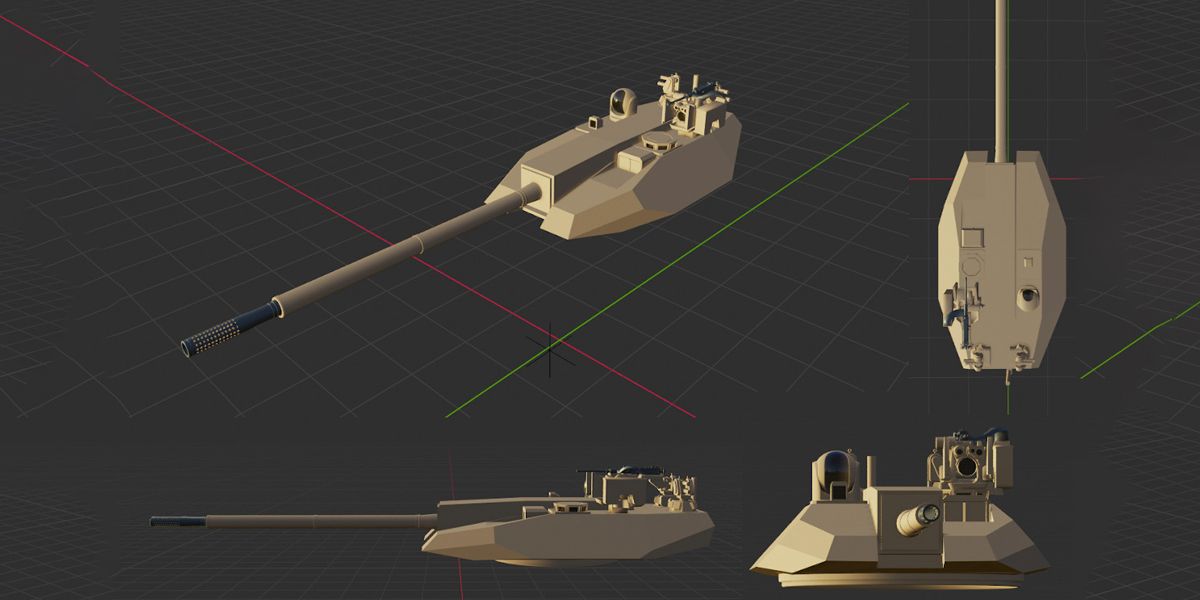
What Will the Army's M1 Abrams Tank Replacement Look Like?
Let's analyze the clues.
- Joined
- 19 July 2016
- Messages
- 4,279
- Reaction score
- 3,462
Possibly the long awaited espresso and milk frother to the BV. Just the job.In 2021 seems will be testing M1A2 SEP V4 Super Abrams or denominated like version M1A2D . Last version for now are M1A2C ( in service) and M1A2D ready for testing on 2021.
Not to sound too pessimistic, but what’s going to be super?
True progress.Possibly the long awaited espresso and milk frother to the BV. Just the job.In 2021 seems will be testing M1A2 SEP V4 Super Abrams or denominated like version M1A2D . Last version for now are M1A2C ( in service) and M1A2D ready for testing on 2021.
Not to sound too pessimistic, but what’s going to be super?
Mitsubishi
ACCESS: Restricted
- Joined
- 1 October 2020
- Messages
- 1
- Reaction score
- 0
Militaryphotos.net
www.militaryphotos.net
Hi, what’s the type?JohnR said:I remember seeing a TV programme a few years ago, that feature a prototype or technology demonstrator of a tank that was about 2/3 of the size of an M1 and had a hexagonal gun tube. Has anyone got any details on this?
Regards
All I have is the pictures below... And a link: http://www.militaryphotos.net/forums/showthread.php?89616-the-new-US-tank
Kat Tsun
eeeeeeeeeeeeeee
- Joined
- 16 June 2013
- Messages
- 1,371
- Reaction score
- 1,778
The short tank is called Wombat.
It was just a tiny, mobile mockup. I think it was powered by a sedan engine or something. The US Army's TARDEC/TACOM (Tank and Automotive Research, Development, Engineering Command/Tank and Automotive COMmand) basically just built it in a garage to prove that they could theoretically make a tank tinier than T-80/T-72/T-64.
edit: It was also called HD-40T, presumably the "40T" meant 40 tons. I think it was part of the Future Combat System (singular) which was a TARDEC study looking at what a smaller, lighter M1 would look like. That whole study and associated mockup was done between '93 and '95. It vanished when they realized there was no tangible difference in mobility between 40 tons and 55 tons I guess. Then Future Combat Systems (plural) starts and they decide to try to make a 20 tons thing to replace M1 instead.
The TARDEC official history is sort of vague on Wombat, basically just mentioning a Discovery Channel show it was in and a picture of thing, because it's mostly an awkward looking footnote.
The weird rhombus barrel shroud is probably to get rid of radar reflections caused by ordinary round barrels; at the time, everyone and their dog was sort of obsessed with copying stealth fighters.
tl;dr: It was a mockup of a futuristic tank to replace M1. Then the US Army decided to make FCS Manned Ground Vehicle instead.
edit2: Muv-Luv is based.
It was just a tiny, mobile mockup. I think it was powered by a sedan engine or something. The US Army's TARDEC/TACOM (Tank and Automotive Research, Development, Engineering Command/Tank and Automotive COMmand) basically just built it in a garage to prove that they could theoretically make a tank tinier than T-80/T-72/T-64.
edit: It was also called HD-40T, presumably the "40T" meant 40 tons. I think it was part of the Future Combat System (singular) which was a TARDEC study looking at what a smaller, lighter M1 would look like. That whole study and associated mockup was done between '93 and '95. It vanished when they realized there was no tangible difference in mobility between 40 tons and 55 tons I guess. Then Future Combat Systems (plural) starts and they decide to try to make a 20 tons thing to replace M1 instead.
The TARDEC official history is sort of vague on Wombat, basically just mentioning a Discovery Channel show it was in and a picture of thing, because it's mostly an awkward looking footnote.
The weird rhombus barrel shroud is probably to get rid of radar reflections caused by ordinary round barrels; at the time, everyone and their dog was sort of obsessed with copying stealth fighters.
tl;dr: It was a mockup of a futuristic tank to replace M1. Then the US Army decided to make FCS Manned Ground Vehicle instead.
edit2: Muv-Luv is based.
Last edited:
Source?
- Joined
- 4 July 2010
- Messages
- 2,514
- Reaction score
- 3,091
It's going around on Twitter. Rumint is that someone on a Russian forum posted them, no indication if it's something they dug up or hacked out of someone's powerpoint. Or if they just made 'em up.
View: https://twitter.com/TheDeadDistrict/status/1327908735063367680?s=19
View: https://twitter.com/TheDeadDistrict/status/1327908735063367680?s=19
- Joined
- 21 April 2009
- Messages
- 13,756
- Reaction score
- 7,695
It was a US Army design exercise that got leaked I think, not 100%Source?
shin_getter
ACCESS: Top Secret
- Joined
- 1 June 2019
- Messages
- 1,105
- Reaction score
- 1,484
Well, if vehicle counts in the field is not a huge constraint (as in enemy is outmatched), there is little pressure to multirole.
The real question is: where are the specs for the APS system? What are the sensor performance (range/Ewar resistence/coverage/sensor fusion/ESM vulnerability/etc), interceptor performance (interceptor load for each arc, maximum engagement rate, maximum range (to counter standoff top attack EFP), etc) What are the soft kill system that will have to save its life under saturation attack?
Some part of me is wondering if the correct future close combat concept is to just fight under a persistent smoke cloud while fighting using high resolution radar (including ground penetrating and wall penetrating variants), high accuracy maps and localization (probably involving LIDAR, now cheap). I'm saying that one has positioning so precise, one and achieve accurate "blind"- direct fires using battle network data. Perhaps shooting "through" structures to hit stuff on the other side is the correct way to use tanks with guns of extreme kinetic penetration and high tech fuzing.
The real question is: where are the specs for the APS system? What are the sensor performance (range/Ewar resistence/coverage/sensor fusion/ESM vulnerability/etc), interceptor performance (interceptor load for each arc, maximum engagement rate, maximum range (to counter standoff top attack EFP), etc) What are the soft kill system that will have to save its life under saturation attack?
Some part of me is wondering if the correct future close combat concept is to just fight under a persistent smoke cloud while fighting using high resolution radar (including ground penetrating and wall penetrating variants), high accuracy maps and localization (probably involving LIDAR, now cheap). I'm saying that one has positioning so precise, one and achieve accurate "blind"- direct fires using battle network data. Perhaps shooting "through" structures to hit stuff on the other side is the correct way to use tanks with guns of extreme kinetic penetration and high tech fuzing.
Colonial-Marine
UAVs are now friend, drones are the real enemy.
- Joined
- 5 October 2009
- Messages
- 1,470
- Reaction score
- 1,323
Pretty nice models. I don't think any of the turrets are completely unmanned though, 1 and 2 look like low profile turrets while 3 is more traditional. It's interesting that there are hatches for two crew members in the hull which suggests a crew of four on all variants, though I'm guessing all of these feature an autoloader.
The number of shells carried seem a bit low on variant #1. I think they should aim for 42 shells total like on the M1A2.
The APS suite on these vehicles is certainly going to easily be as crucial as the armor itself. I hope to see a setup that includes both soft and hard kill systems.
I don't think having a true indirect fire capable gun is worth it. That's the job of artillery. If you really need to hit a target that is out of line-of-sight you load up an advanced ATGM with NLOS capability.
The number of shells carried seem a bit low on variant #1. I think they should aim for 42 shells total like on the M1A2.
The APS suite on these vehicles is certainly going to easily be as crucial as the armor itself. I hope to see a setup that includes both soft and hard kill systems.
I don't think having a true indirect fire capable gun is worth it. That's the job of artillery. If you really need to hit a target that is out of line-of-sight you load up an advanced ATGM with NLOS capability.
Berserker95
ACCESS: Restricted
- Joined
- 12 April 2020
- Messages
- 8
- Reaction score
- 10
- Joined
- 27 December 2005
- Messages
- 17,748
- Reaction score
- 26,414
What is this?
My guess, a very well done artist impression of three potential M1 MBT replacements, in a hanger.
- Joined
- 19 July 2016
- Messages
- 4,279
- Reaction score
- 3,462
More like an artistic impression, albeit nicely done, of three tanks in a hanger. The replacement bit is moot at the moment.
- Joined
- 16 April 2008
- Messages
- 9,605
- Reaction score
- 14,494
There's an alleged US Army study of several Optionally Manned Tank concepts floating around, mostly on Russian internet sites (which makes me highly skeptical of it). This pic seems to be a rendering of the three designs.
When all that was showing up was the renders and some specs, I assumed it was just some well-disguised fan art. The latest sites I've seen have some very plausible user comments, which make me think this may be legit.
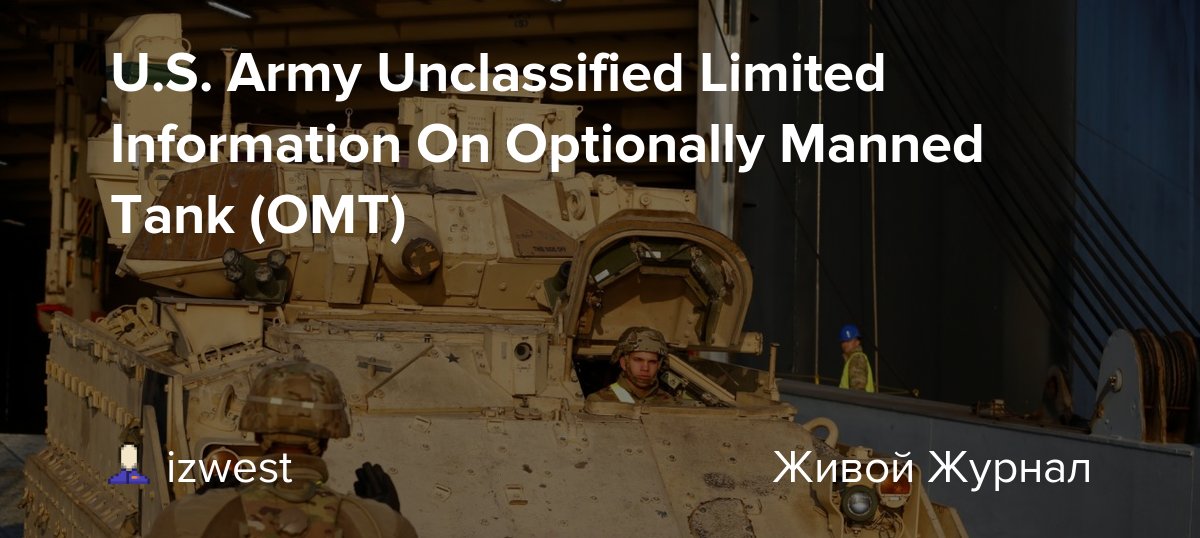
 izwest.livejournal.com
izwest.livejournal.com
Seems like it might be the output from events like this one:
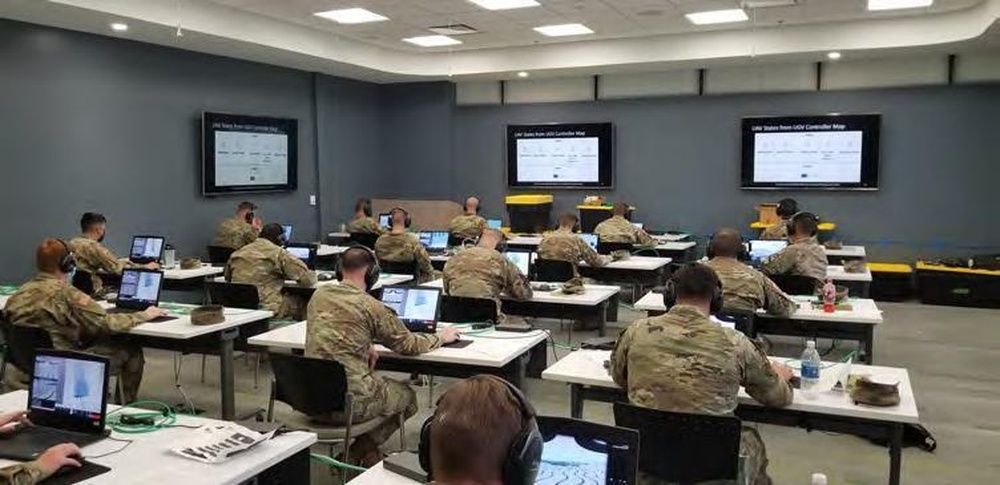
 www.dvidshub.net
www.dvidshub.net
When all that was showing up was the renders and some specs, I assumed it was just some well-disguised fan art. The latest sites I've seen have some very plausible user comments, which make me think this may be legit.
U.S. Army Unclassified Limited Information On Optionally Manned Tank (OMT)
Donate Click to see full-size image U.S. Army Fort Benning and the Maneuver Center of Excellence has declassified images of four future Optionally Manned Tank (OMT) concepts to replace the US M1 Abrams main battle tanks. There are also early specifications sheets for the first 3 variants of the…
Seems like it might be the output from events like this one:

Army Conducts Virtual Experiment on Future Tank
Today’s armor Soldiers are helping to inform early development and engineering decisions on the Army’s next tank through Virtual Prototyping.
stimpy75
Happy Happy,Joy Joy
- Joined
- 23 August 2007
- Messages
- 188
- Reaction score
- 325
a friend of mine posted these pics first at an discord channel, he had them from a friend from the Army (dont want to get into details)
he himself is a small arms weapons designer and ex TheFirearmBlog member
he specified not to share these pics, but somehow it landed on the octavaga forum....and the rest is history
he himself is a small arms weapons designer and ex TheFirearmBlog member
he specified not to share these pics, but somehow it landed on the octavaga forum....and the rest is history
Berserker95
ACCESS: Restricted
- Joined
- 12 April 2020
- Messages
- 8
- Reaction score
- 10
Well these are only TARDEC concepts. Who knows if the Army will ever prototype them. General Dynamics is the only company in the states that can build MBTs so I would assume they will be the lead designer for OMT. Most likely it will be based on the M1 hull.a friend of mine posted these pics first at an discord channel, he had them from a friend from the Army (dont want to get into details)
he himself is a small arms weapons designer and ex TheFirearmBlog member
he specified not to share these pics, but somehow it landed on the octavaga forum....and the rest is history
The one on the left reminds me of Armata the middle one Merkava Mk1 and the one on the right an AMX 32/40.
What is the engine position on the left hand one and middle one.
- Joined
- 4 July 2010
- Messages
- 2,514
- Reaction score
- 3,091
They're marked Distribution D, so there's potentially a whole lot of people who could have been the source rather than your friend or his source.a friend of mine posted these pics first at an discord channel, he had them from a friend from the Army (dont want to get into details)
he himself is a small arms weapons designer and ex TheFirearmBlog member
he specified not to share these pics, but somehow it landed on the octavaga forum....and the rest is history
jsport
what do you know about surfing Major? you're from-
- Joined
- 27 July 2011
- Messages
- 7,732
- Reaction score
- 5,751

How the Army plans to revolutionize tanks with artificial intelligence
With the Advanced Targeting and Lethality Aided System, or ATLAS, the U.S. Army hopes to transform the way tank crews operate using artificial intelligence. (U.S. Army)
The slide to the Cylon wars begins?!?!?!
How the Army plans to revolutionize tanks with artificial intelligence
With the Advanced Targeting and Lethality Aided System, or ATLAS, the U.S. Army hopes to transform the way tank crews operate using artificial intelligence. (U.S. Army)www.c4isrnet.com
- Joined
- 22 January 2006
- Messages
- 4,213
- Reaction score
- 2,010
Resistance is futile. Humankind agree about the dangers of AI but nobody can stop its development because AI promises superiority at the battlefield and economy.The slide to the Cylon wars begins?!?!?!
The singularity will find us sooner or later. May be we should start working on counter mesures?
Counter measures? Like thicker tin foil?Resistance is futile. Humankind agree about the dangers of AI but nobody can stop its development because AI promises superiority at the battlefield and economy.The slide to the Cylon wars begins?!?!?!
The singularity will find us sooner or later. May be we should start working on counter mesures?
- Joined
- 19 July 2016
- Messages
- 4,279
- Reaction score
- 3,462
Bacofoil, the one and only, positively guaranteed to do something other than get in the way when carving the Turkey........
shin_getter
ACCESS: Top Secret
- Joined
- 1 June 2019
- Messages
- 1,105
- Reaction score
- 1,484
It is a question to me that whether it is correct to demand the next tank to kinetically penetrate the "best armored plates" of conceivable peers.
The unmanned turret tanks enable a significant reduction in frontal surface area, which translates demand for Guns with increased power to penetrate the new "strongest plates." This means greater than historical tradeoffs with performance in other roles: large ammo, cost, difficulty in maneuvering in dense terrain, difficulty in integrating lower velocity ammo, elevation limits, and so on.
Now, a gun capable of penetrating opponent vehicles has been important as it has been the primary way of defeating vehicles, however things have changed a lot since WWII. Air power influences land vehicle combat at ever increasing amounts, denying direct vehicle on vehicle combat. Improvement in long range fire complexes and BLOS weapons means "battles at range" between mobile vehicles is increasingly a thing, pushed by fast targeting cycles in depth for counter battery duels. Missiles still remain effective at a fraction of the weight and cost of gun installations. While armor can be increased, sensors and weapons (at least other guns) is not any less vulnerable and firepower kills without penetration has become relatively easier. Instead of gun penetration, one can go for top attack, KEM, or non-penetrating mission kills.
KE Gun fire is likely to remain superior at close range engagements while engaging large number of targets. However is this realistic? How likely is a tank to be in position to defeat a hoard of "maximum 130mm+ HV gun armor penetration required targets" at short range while not dying to return or support fires in the process?
Some people think APS will remove the impact of the missile, however that doesn't seem likely. KEM does gun at lower cost/weight installation, minus minimal range. Top attack defense against standoff EFP is generalized C-RAM problem and that is more expensive than armor arrays and easy to saturate. The cost reduction in expensive active defense sensors will also likely happen at in conjunction to cost reduction in reliable munition guidance (the most expensive part of PGMs) and improvement in long range detection and targeting ability against vehicles.
It is not inconceivable that battles between Future "MBTs" ending up with networked BLOS GLATGM exchanges as low cost effective elevated (flying or masted) long range sensors provides sufficient targeting, nevermind combat against all lighter forces that have even less reason to close.
-----------
So what can you do if you dropped the requirement to frontally penetrate the opposing tank with the gun?
1. Add APS/C-RAM ability for even better protection
2. Add even more armor
3. Add long range (BLOS) capability
4. Add mobility
5. and so on....
---------------------------------------------------
Some earlier part of the thread talked about the weakness of multi-role vehicles as obviously of inferior performance at each role and "inability to concentrate" on a role.
Well, the MBT is terrible!1!!1111! We all know that there ought to be division into infantry support tanks, deep exploitation tanks, anti-tank tanks, urban warfare tanks, super heavy assault tanks, flame thrower tanks and machine gun tanks. After all, if the MBT is shooting up a structure it isn't shooting at other tanks thus there is no concentration of force, while a combined force of the diverse tank fleet can do it all!
*alternatively, pentagon wars clip*
Okay, sarcasm aside, the universal (aka multirole) tank's main value is shown in the high intensity warfare of ww2. In high intensity warfare, the enemy sets the conditions half the time and you'd almost never have the right assets in the right amount in the right place and time. It is easy to say, the artillery wouldn't do direct fire. You can not impose that when the enemy's plans works and enemy tanks end up running into rear line artillery force. You can't say that heavy tanks never should be used for exploitation when an assault on limited recon unexpectedly hits a weak point and collapses the enemy front when you are prepared to attritional fight. The difficult enemy is one that one can not gain such information superiority over as to enable control of the conflict to fit capabilities. The more one is surprised the more important multi-role gets.
With changing technology it would be natural that the breakdown of vehicle roles would change based on needs of the battlefield and capabilities of the technology, and vehicle spanning different roles would be fine if there is synergy.
Fleets of specialists is for fighting non-peers that have no initiative and one can shuffle forces around however needed to accomplish the goal.
The unmanned turret tanks enable a significant reduction in frontal surface area, which translates demand for Guns with increased power to penetrate the new "strongest plates." This means greater than historical tradeoffs with performance in other roles: large ammo, cost, difficulty in maneuvering in dense terrain, difficulty in integrating lower velocity ammo, elevation limits, and so on.
Now, a gun capable of penetrating opponent vehicles has been important as it has been the primary way of defeating vehicles, however things have changed a lot since WWII. Air power influences land vehicle combat at ever increasing amounts, denying direct vehicle on vehicle combat. Improvement in long range fire complexes and BLOS weapons means "battles at range" between mobile vehicles is increasingly a thing, pushed by fast targeting cycles in depth for counter battery duels. Missiles still remain effective at a fraction of the weight and cost of gun installations. While armor can be increased, sensors and weapons (at least other guns) is not any less vulnerable and firepower kills without penetration has become relatively easier. Instead of gun penetration, one can go for top attack, KEM, or non-penetrating mission kills.
KE Gun fire is likely to remain superior at close range engagements while engaging large number of targets. However is this realistic? How likely is a tank to be in position to defeat a hoard of "maximum 130mm+ HV gun armor penetration required targets" at short range while not dying to return or support fires in the process?
Some people think APS will remove the impact of the missile, however that doesn't seem likely. KEM does gun at lower cost/weight installation, minus minimal range. Top attack defense against standoff EFP is generalized C-RAM problem and that is more expensive than armor arrays and easy to saturate. The cost reduction in expensive active defense sensors will also likely happen at in conjunction to cost reduction in reliable munition guidance (the most expensive part of PGMs) and improvement in long range detection and targeting ability against vehicles.
It is not inconceivable that battles between Future "MBTs" ending up with networked BLOS GLATGM exchanges as low cost effective elevated (flying or masted) long range sensors provides sufficient targeting, nevermind combat against all lighter forces that have even less reason to close.
-----------
So what can you do if you dropped the requirement to frontally penetrate the opposing tank with the gun?
1. Add APS/C-RAM ability for even better protection
2. Add even more armor
3. Add long range (BLOS) capability
4. Add mobility
5. and so on....
---------------------------------------------------
Some earlier part of the thread talked about the weakness of multi-role vehicles as obviously of inferior performance at each role and "inability to concentrate" on a role.
Well, the MBT is terrible!1!!1111! We all know that there ought to be division into infantry support tanks, deep exploitation tanks, anti-tank tanks, urban warfare tanks, super heavy assault tanks, flame thrower tanks and machine gun tanks. After all, if the MBT is shooting up a structure it isn't shooting at other tanks thus there is no concentration of force, while a combined force of the diverse tank fleet can do it all!
*alternatively, pentagon wars clip*
Okay, sarcasm aside, the universal (aka multirole) tank's main value is shown in the high intensity warfare of ww2. In high intensity warfare, the enemy sets the conditions half the time and you'd almost never have the right assets in the right amount in the right place and time. It is easy to say, the artillery wouldn't do direct fire. You can not impose that when the enemy's plans works and enemy tanks end up running into rear line artillery force. You can't say that heavy tanks never should be used for exploitation when an assault on limited recon unexpectedly hits a weak point and collapses the enemy front when you are prepared to attritional fight. The difficult enemy is one that one can not gain such information superiority over as to enable control of the conflict to fit capabilities. The more one is surprised the more important multi-role gets.
With changing technology it would be natural that the breakdown of vehicle roles would change based on needs of the battlefield and capabilities of the technology, and vehicle spanning different roles would be fine if there is synergy.
Fleets of specialists is for fighting non-peers that have no initiative and one can shuffle forces around however needed to accomplish the goal.
Last edited:
They clearly looked at the specialised tank/hevy armour at the end of WW2, with the T95, Tortoise etc. As you say, it being in the right place to meet the enemy Tortoise can only lead to jokes about tortoise racing.
What I think you suggest sounds like some of the Sci-Fi battles, once you run out of decoys/cant absorb any more energy/heat, you explode in a blaze of atoms.
I see a decoy battle. So currently Tanks are directional - i.e. heaviest armour to the front. with the available tech, you would be able to spot that tank, launch 4-6 remote ATGM pods, around it 2-3 at the front, 1 each side and rear. Not all pods need to be real/live, or can have an unguided rocket. Aim is to overload the tank, and your definite live guided round is the one at the rear/sides.
Logically, this means tanks become non-directional, same armour all round, crew in the middle. The battle would be decided by sensors, and who had the most ATGM pods/ APS shots.
Equally well, doesnt this sound like the age of battleships - the last few conflicts that came anywhere near Tank v Tank, were heavily decided by Aircraft/guided weapons/AT Helicopters, and now sensor and attack drones.
So does the tank go back to being the guy that has to go in and check the drones didnt miss anything, and to collect the surviving prisoners, i.e. escorting the heavy APC's, with drone cover/detection/destruction, and with robot escorts doing the close work.
What I think you suggest sounds like some of the Sci-Fi battles, once you run out of decoys/cant absorb any more energy/heat, you explode in a blaze of atoms.
I see a decoy battle. So currently Tanks are directional - i.e. heaviest armour to the front. with the available tech, you would be able to spot that tank, launch 4-6 remote ATGM pods, around it 2-3 at the front, 1 each side and rear. Not all pods need to be real/live, or can have an unguided rocket. Aim is to overload the tank, and your definite live guided round is the one at the rear/sides.
Logically, this means tanks become non-directional, same armour all round, crew in the middle. The battle would be decided by sensors, and who had the most ATGM pods/ APS shots.
Equally well, doesnt this sound like the age of battleships - the last few conflicts that came anywhere near Tank v Tank, were heavily decided by Aircraft/guided weapons/AT Helicopters, and now sensor and attack drones.
So does the tank go back to being the guy that has to go in and check the drones didnt miss anything, and to collect the surviving prisoners, i.e. escorting the heavy APC's, with drone cover/detection/destruction, and with robot escorts doing the close work.
- Joined
- 21 April 2009
- Messages
- 13,756
- Reaction score
- 7,695
While I probably haven’t seen all the videos from Syria and the latest conflict in Azerbaijan what I have not seen is a single main gun tank kill of another tank. Lots of ATGMs and drone kills howeverJust have a smart swarm of tiny drones come in and punch holes in the other guy's main guns with shaped charges. Done.
- Joined
- 19 July 2016
- Messages
- 4,279
- Reaction score
- 3,462
Their ability to disrupt drones is basically non existent, somewhat different for the major powers from what I have seen.
marauder2048
"I should really just relax"
- Joined
- 19 November 2013
- Messages
- 3,157
- Reaction score
- 926
Missiles are at least an order of magnitude more expensive than the most expensive cannon fired Kinetic energy penetrators.Missiles still remain effective at a fraction of the weight and cost of gun installations.
If you select missiles as your main armament and the number of stowed kills stays the same, gun designers
are going to be able to show that they can apply all of the exotic weight reduction techniques that were previously
regarded as cost prohibitive.
The same would apply to all of the "exotic" concepts for enhancing cannon muzzle velocities or
to an extent gun launched guided rounds since there is quite a bit of work on guided rounds for
medium caliber and artillery tubes.
Also - everyone seems to focus on penetration - how useable is a tank after a hit on the turret, that doesnt penetrate - sensors will be down, comms, APS in some areas?
Or a hit that takes out the tracks?
That tank is going to try and withdraw - or need engineers and some time to get it going.
Or a hit that takes out the tracks?
That tank is going to try and withdraw - or need engineers and some time to get it going.
marauder2048
"I should really just relax"
- Joined
- 19 November 2013
- Messages
- 3,157
- Reaction score
- 926
I think the ballistic shock requirements are the same rough order of magnitude as the shock requirements for withstandingAlso - everyone seems to focus on penetration - how useable is a tank after a hit on the turret, that doesnt penetrate - sensors will be down, comms, APS in some areas?
the main gun firing.
shin_getter
ACCESS: Top Secret
- Joined
- 1 June 2019
- Messages
- 1,105
- Reaction score
- 1,484
The question is how many LOS "anti-tank" stowed kills is needed? It should also be noted that historical ammo count is not representative: accuracy was poor and pk was low per shot. When pk is high and shots are not used for suppressive effects, ammo needs are low.Missiles are at least an order of magnitude more expensive than the most expensive cannon fired Kinetic energy penetrators.
If you select missiles as your main armament and the number of stowed kills stays the same, gun designers
are going to be able to show that they can apply all of the exotic weight reduction techniques that were previously
regarded as cost prohibitive.
The problem with using a large, really high velocity gun is that your stowed kills against other targets is reduced. There is orders of magnitudes more infantry, more mini-ugv, micro-uav, holes in the ground, light/medium vehicles that needs servicing.
The previous conflicts in the past few decades have shown extremely few tank on tank engagements, and none that had a strategic impact.
-----------------
Even if we assume a conflict where formation tank on tank battle occurs, how likely is it we need large number of LOS stowed kills? Should we commonly expect 5+ kills per rearm against against a opponent that needs 130mm+ HV guns to defeat? As the life expectancy of the combat vehicle goes down the amount of stored kill needed also goes down since it is unlikely to fire them all.
You need a opponent that:
1. Manage to penetrate USAF fires
2. Manage to penetrate army BLOS fires
3. Arrive at front in dense, numerically superior force
4. With the American tank force not neutralized by enemy long range fires
5. That has combat power that defeats Abrams by protection but is utterly ineffective against FMBT in LOS combat, taking multiple losses per FMBT
6. Yet persist in engaging as opposed to disengaging
7. Under conditions where the American forces can not just disengage as well
8. While being the highly significant point of conflict
The problem is that #1, #2 is extremely hard, while matching FMBT on #5 is fairly easy as it is detected when it fires and joint fires or missiles (of sufficient capability) can defeat it, even if gun development is lagging. Even if technology is unavailable, Brute force methods like huge Kinetic kill missiles or large missiles salvos is still more economic than horrible exchange ratios, and it is not really conceivable way that a FMBT can be defended against all those methods and still pack a big gun and ammo and have mobility. It is also unlikely that sensor outmatch could enable large kill counts as LOS is limited and commercial thermals is getting good enough.
In any case even if this scenario is not literally impossible it is still likely to be very implausible, and optimizing for it as opposed to all the other very common scenarios is wasteful.
-------------------
Though thinking about the constraints a bit, I think huge number cheap stowed kills can enable completely different engagement logic. One can start firing semi-blind into smoke, cover, and poorly localized radar signatures and likes. However with a big chemical gun is still too constrained by ammo count and such such tactic would probably have to wait till practical railguns. You probably also need an anti-sensor revolution for this to be actually useful.
Similar threads
-
M60 tank upgrades (Super M60, M60-2000 etc)
- Started by Pyrrhic victory
- Replies: 30
-
US Army's 1990s Armored Systems Modernization (ASM) Program (FIFV, Block III Tank, Crusader)
- Started by RyanC
- Replies: 77
-
-
Tank Thermal Sights in the Cold War
- Started by Logan Hartke
- Replies: 17
-

